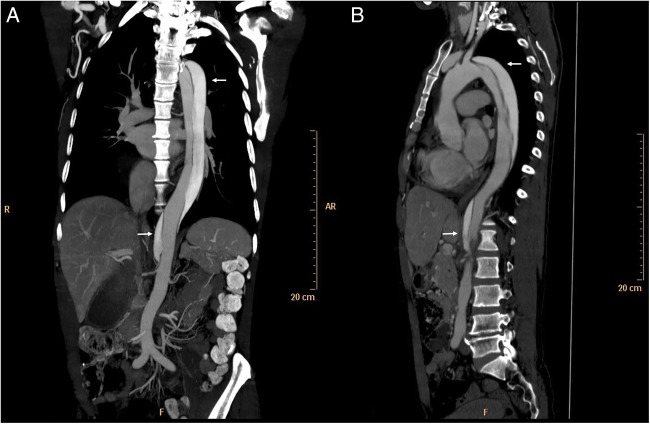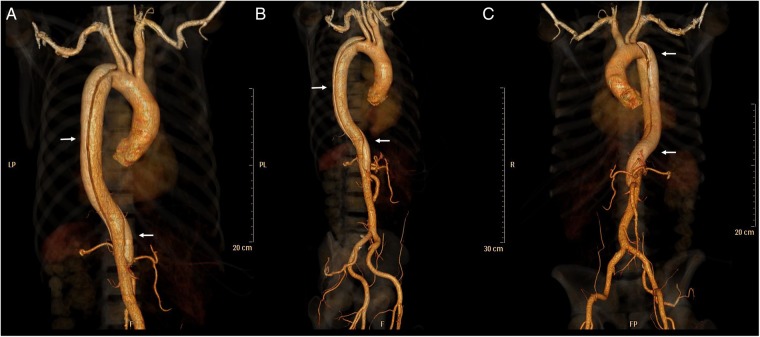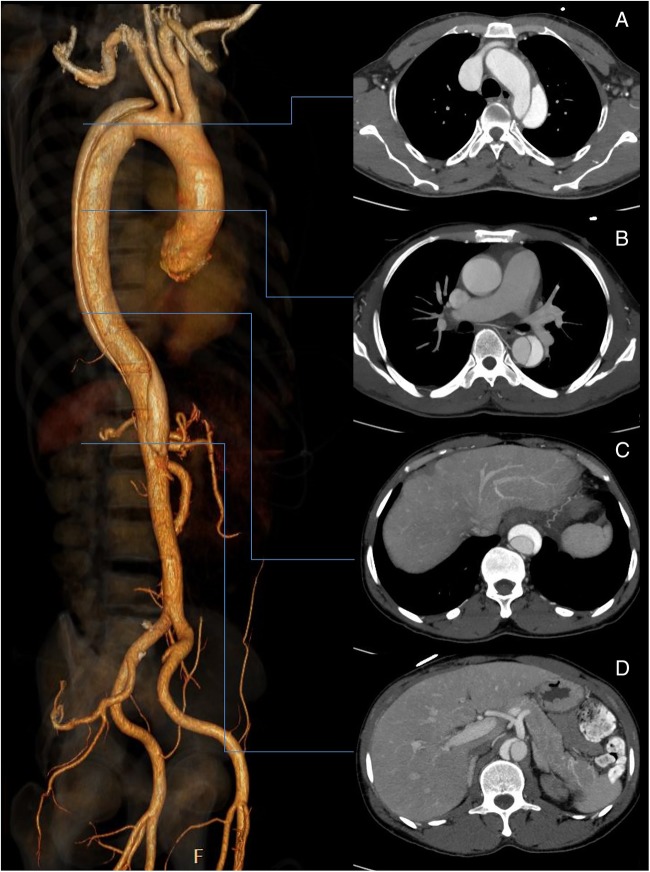Description
A 61-year-old African-American patient presented to the emergency room with severe back pain. The patient had a history of end-stage renal disease on haemodialysis for 6 years, chronic obstructive lung disease and uncontrolled hypertension. CT scan revealed type B aortic dissection extending from the left subclavian artery to the right renal artery (figures 1–3). There were no signs or symptoms of malperfusion. The patient was medically managed; blood pressure control required four different classes of antihypertensive drugs. It should be noted that the patient had consistently refused antihypertensive treatment previously. At 5 months of follow-up, the patient was asymptomatic and the dissection was stable.
Figure 1.
CT scan—aortic dissection extending from left subclavian artery to right renal artery. (A) Coronal plane. (B) Sagittal plane.
Figure 2.
CT three-dimensional reconstruction with true and false lumens (arrows) extending from left subclavian artery to right renal artery. (A) Posterior incidence. (B) Right lateral incidence. (C) Anterior incidence.
Figure 3.
CT three-dimensional reconstruction with true and false lumens (arrows) extending from left subclavian artery to right renal artery. Left lateral incidence. (A–D) Four transverse plane sections.
Aortic dissection is characterised by separation of the layers within the aortic wall. The incidence of acute aortic dissection is estimated to range from 3.5 to 14 per 100 000 person-years while in-hospital mortality is 27.4%.1 2 Although the clinical presentation might include aortic regurgitation, cardiac tamponade and end-organ ischaemia, the single most common symptom is sudden onset of severe chest pain.2 Notably, the most common predisposing factor is a history of hypertension, being present in more than 70% of patients and being more common in type B dissection. Although patients with type B dissection present decreased mortality when compared to type A dissection patients, they tend to be older, have higher rates of atherosclerosis and are more likely to present with back pain rather than anterior chest pain.2 Treatment options include medical therapy comprising β-blockers and surgical or endovascular intervention.
Learning points.
Aortic dissection, which is more common in men and older people, has many predisposing factors including hypertension (most common), male gender, older age, vasculitis, disorders of collagen, bicuspid aortic valve, aortic coarctation and cocaine use.
According to the Stanford classification, which has treatment and prognostic implications, aortic dissection can be categorised as type A, when the ascending aorta is involved, or as type B, when aortic dissection occurs distally to the left subclavian artery.2
Aortic dissection diagnosis in haemodialysis patients requires a high index of suspicion as clinical presentation may be suggestive of many other conditions and only a small number of cases have been reported in this population.3
Acknowledgments
The authors thank the CT radiographer, Rui Araújo, for three-dimensional image processing.
Footnotes
Competing interests: None declared.
Patient consent: Obtained.
Provenance and peer review: Not commissioned; externally peer reviewed.
References
- 1.Patel AY, Eagle KA, Vaishnava P. Acute type B aortic dissection: insights from the International Registry of Acute Aortic Dissection. Ann Cardiothorac Surg 2014;3:368–74. doi:10.3978/j.issn.2225-319X.2014.07.06 [DOI] [PMC free article] [PubMed] [Google Scholar]
- 2.Hagan PG, Nienaber CA, Isselbacher EM et al. The International Registry of Acute Aortic Dissection (IRAD): new insights into an old disease. JAMA 2000;283:897–903. doi:10.1001/jama.283.7.897 [DOI] [PubMed] [Google Scholar]
- 3.Tong Y, Wang Q, Hou Z. Aortic Dissection and Hemodialysis: A Case Report. Dial Transplant 2007;36:543–51. [Google Scholar]





